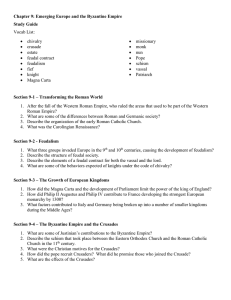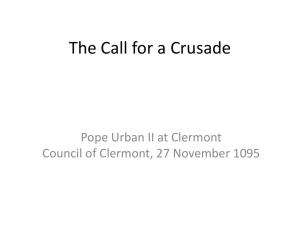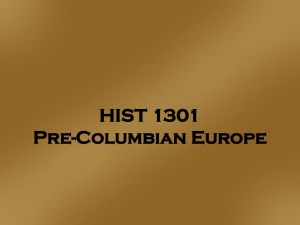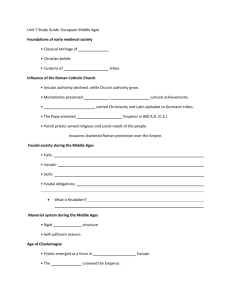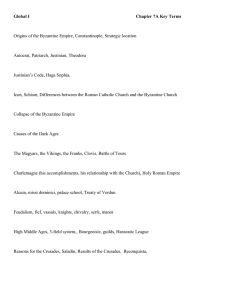Document 17795353
advertisement
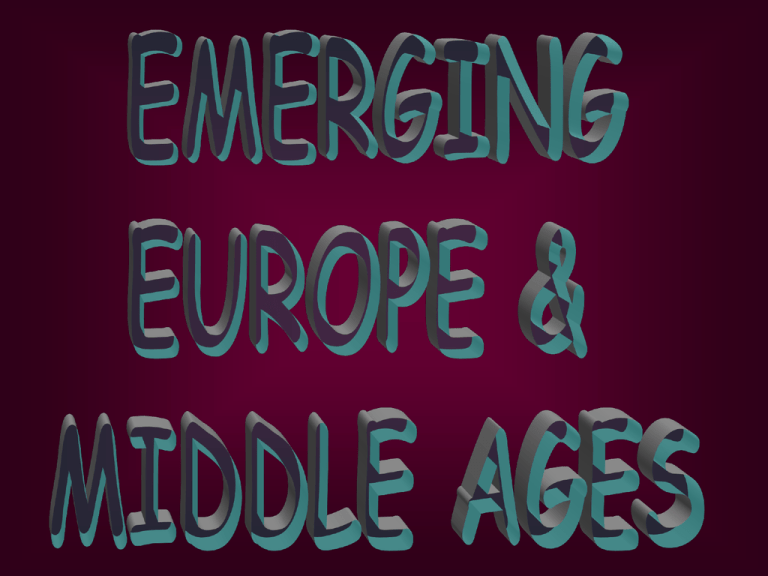
CAROLINGIAN EMPIRE • The Roman Empire began to fall apart soon after Charlemagne’s death in 814. • By 844, the empire had been divided into three kingdoms by Charlemagne’s grandsons. • Invasions also added to the disintegration. Romans could not defend their borders. • The beginning of the DARK AGES: • --Little formal education for the masses. • The fall of Rome leads to FEUDALISM. INVASION • Muslims invaded southern France, and the Magyars from western Asia settled on the plains of Hungary and invaded western Europe. • The Vikings, a Scandinavian peoples, invaded Europe, sacking towns, destroying churches, raping and stealing women, and defeating armies. THE VIKINGS • The Vikings were superb warriors, sailors, and shipbuilders. • Their famous dragon ships were long and narrow with carved, arched prows that carried about 50 men. • These dragon ships allowed sailing up shallow rivers to attack inland. VIKING SETTLEMENTS • By the mid-9th century Franks eventually settled and Christianized the Vikings. • In 911, a Frankish ruler gave a band of Vikings the land that became known as Normandy. FEUDALISM • Invaders posed a threat to the safety of the people, especially in the absence of a strong central government. • People began to turn to local landed aristocrats or nobles to protect them. • This change led to the new political, social system called feudalism. VASSELAGE • Feudalism arose between 800 and 900 and thrived for 400 years. • At the heart of this system was the idea of vassalage. • It came from Germanic society, where warriors swore an oath to their leader. • By the 8th century, a man who served a lord militarily was known as a vassal. KNIGHTS • For the next 500 years, heavily armored cavalry called knights dominated warfare. • They had great prestige and formed the backbone of the European aristocracy. SOCIAL HIERARCHY • In the Early Middle-Ages (500-1000), wealth was based on owning land. • There was little trade. • When nobles wanted men to fight for them, they granted the vassal a piece of land that supported the vassal and his family. LOYALTY & LAND • The relationship between lord and vassal was made official by a public act of homage of vassal to the lord. • Loyalty to one’s lord was feudalism’s chief virtue. FIEF • By the 9th century the land the lord granted to a vassal was known as a fief. • Vassals had political authority in their fiefs. • The number of separate powerful lords and vassals increased; many different people were now responsible for keeping order. FEUDAL CONTRACT • Feudalism became complicated. • Kings had vassals who themselves had vassals. • Feudalism came to be characterized by a set of unwritten rules known as the feudal contract. • These rules determined the relationship between lord and vassal. • The major obligation of a vassal was military service, about 40 days a year. CASTLES • The growing number of castles made visible the growth of the nobility in the High Middle Ages (1000-1300). • Castles were the permanent residences and fortresses. • Castles had two parts; – The Motte- a natural or artificially created hill – The Bailey- an open space. THE KEEP • The castle’s central building, the keep, was built on the motte. • All were encircled by large, stone walls. • The keep included a great hall where the lord held court and received visitors, and people ate and even slept. • As lords got wealthier, the castles became more complex and ornate. WILLIAM OF NORMANDY • Since King Alfred the Great had united various AngloSaxon kingdoms in the late 9th century, Anglo-Saxon kings had ruled England. • In 1066, an army commanded by William of Normandy defeated King Harold of England at the Battle of Hastings. • William was crowned King of England. DOMESDAY BOOK • The French speaking Normans and the Anglo-Saxon nobility gradually merged into a new English culture. • William took the first census in western Europe since Roman times, known as the Domesday Book. • He also developed the system of taxation and royal courts earlier Anglo-Saxon kings had begun. HENRY II • Henry II, ruled from 1154-1189 and enlarged the power of the English monarchy. • He expanded the royal courts’ powers to cover more criminal and property cases. • Because royal courts were all over the land, a body of common law, law common to the whole kingdom, began to replace local codes. THOMAS BECKET • Henry claimed he had the right to punish the clergy in royal courts. • Thomas Becket, archbishop of Canterbury, disagreed. • The angry king expressed his desire to be rid of Becket. • 4 knights took the challenge and killed the archbishop in the cathedral. • An outraged public caused Henry to back off his struggle with the Church. MAGNA CARTA • Resenting the monarchy’s expanding power, many nobles rebelled against King John. • In 1215 at Runnymede, John was forced to agree to a document of rights called the Magna Carta, or Great Charter. • The Magna Carta limited the power of the King and granted citizens more rights. EDWARD I • In the 13th century, during the reign of Edward I, the English Parliament emerged. • Parliament was an important step in developing a representative government. • Under Edward I, it granted taxes and passed laws. EMPEROR JUSTINIAN • Justinian became emperor of the Eastern Roman Empire in 527. • He wanted to restore the full Roman Empire. • By 527 he almost had, but only 3 years later he died and the Lombards conquered Italy. • Shortly after other areas were lost. THE BODY OF CIVIL LAW • Justinian’s most important contribution was his codification of Roman law in the Body of Civil Law. • It was the basis of imperial law until the Eastern Roman Empire ended in 1453. • It also became the basis for the legal system in most of Europe. CONSTANTINOPLE • Justinian’s conquests left the Eastern Roman Empire in serious trouble: – Too far from Constantinople to protect the capital of the Eastern Roman Empire, – An empty treasury – A population decline due to plague – Threats along its frontier ISLAM • The most serious challenge to the Eastern Roman Empire invasion by Islam which had created a powerful united Arab force. • First, the empire lost Syria and Palestine in 636. • In the north the Bulgars defeated the empire’s forces and created a kingdom in the lower Danube Valley. BYZANTINE EMPIRE • By the beginning of the 8th century, the much reduced Eastern Roman Empire consisted only of the eastern Balkans and Asia Minor. • Historians call this the Byzantine Empire. • It was its own distinctive civilization and lasted until 1453. BYZANTINE CULTURE • The Byzantine Empire was both Christian and Greek. • Greek became the empire’s official language, but the empire was built on the Eastern Orthodox Church. PATRIARCH • The emperor’s power was absolute because he was seen as chosen by God and crowned in sacred ceremonies. • He exercised political control over the Church because he appointed the leader, called the Patriarch. • Byzantines believed that God had commanded their state to preserve the true Christian faith. POPE LEO IX SCHISMPATRIARCH M.CERRLARIUS • The Eastern Orthodox would not accept the pope as the head of the Christian faith. • In 1084 Pope Leo IX and Patriarch Michael Cerularius excommunicated each other. • This created a schism or separation between these 2 branches of Christianity. • The schism has not completely healed even today. SELJUK TURKS • The empire’s greatest threat was by the Seljuk Turks who moved into Asia Minor. • Asia Minor was the empire’s chief source of food and workers. • In 1071 a Turkish army defeated Byzantine forces at Manzikert. • Emperor Alexius I turned to Europe for help. THE HUNDRED YEARS WAR • The most violent struggle during the Middle Ages began when King Philip VI of France seized Gascony in 1337. • He attempted to make the Dutch part of France. • King Edward III then declared war on Philip which lasted until 1453. JOAN OF ARC • Joan of Arc was a French peasant woman who unexpectedly saved the timid king Charles of France. • She was a very religious Catholic girl who believed that the saints communicated to her that it was her duty to save France. PURPOSE OF THE CRUSADES • From the 11th to 13th centuries European Christians went on a series of military campaigns to regain the Holy Land from the Muslims, regarded as infidels (nonbelievers). COUNCIL OF CLERMONT • Pope Urban II agreed to help Alexius I. • Among other reasons the Pope wanted to provide papal leadership for a great cause. • At the Council of Clermont in 1084, Pope Urban II urged Christians to take up arms in a holy war. CALL FOR WARRIORS • Warriors from western Europe, especially France, joined up. • Some were moved by the cause; others were moved by adventure, the prospect of fighting, and an opportunity to gain territory, riches or even a title. THE FIRST CRUSADE • The 1st Crusade had an army of several thousand cavalry and 10,000 infantry. • The crusaders went down the Palestinian coast and reached Jerusalem in 1099. • They took the city and massacred thousands of its inhabitants. CRUSADER STATES • The victors formed 4 Latin crusader states which were surrounded by Muslims. • These kingdoms depended on supplies from Europe coming through Italian cities. • Genoa, Pisa, and especially Venice grew rich and powerful. THE SECOND CRUSADE • By the 1140s, the Muslims began to strike back. • When one of the Latin states fell, the monastic leader St. Bernard of Clairvaux attained the help of King Louis VII of France and Emperor Conrad III of German in a 2nd Crusade. • It failed entirely. THIRD CRUSADE • In 1187, Jerusalem fell to the Muslims under Saladin. • 3 Christian rulers agreed to lead a 3rd crusade. • Emperor Frederic Babarossa of Germany, Richard, the Lionheart of England, and Philip II Augustus of France. Richard the Lionheart negotiating rd with The 3 Crusade Saladin SALADIN • was not successful. • Frederick drowned in a local river, Philip II went home to France, and Richard negotiated an agreement with Saladin allowing Christian pilgrims access to Jerusalem. Frederick drowning with his horse in the river Philip II leaving for France THE FOURTH CRUSADE • About 6 years after Saladin’s death in 1193, Pope Innocent III started a 4th Crusade. • The Venetian leaders of the 4th crusade used this situation to weaken their largest commercial competitor, the Byzantine Empire. • The crusaders sacked Constantinople in 1214. FIRST CHILDREN’S CRUSADES • There were 2 children’s crusades. • In 1212, a German youth named Nicholas of Cologne brought thousands of children to the pope saying that God had inspired him to lead the children to the Holy Land. • The pope sent them home. SECOND CHILDREN’S CRUSADE • Another group of about 20,000 French children sailed for the Holy Land. • 2 of the ships went down at sea, and the remainder of the children were sold into slavery on reaching North Africa. EFFECTS OF CRUSADE • The Crusades benefited some Italian cities economically, especially the big banking houses in Florence, Milan and Venice. • One unhappy effect was the 1st widespread European attacks on the Jews that began during the Crusades. • The biggest impact of the Crusades was political because they helped break down feudalism, which led to strong nation-states.
